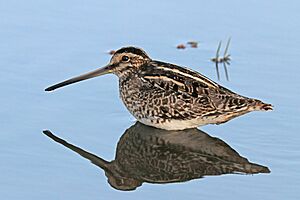African snipe facts for kids
Quick facts for kids African snipe |
|
|---|---|
 |
|
| G. n. aequatorialis Lake Ziway, Ethiopia |
|
| Conservation status | |
| Scientific classification |
The African snipe (Gallinago nigripennis), also called the Ethiopian snipe, is a small, sturdy bird. It's a type of wader, meaning it has long legs for walking in shallow water. These birds live in eastern and southern Africa. They prefer wet mountain areas and swamps. You can find them high up, from about 1,700–4,000 m (5,600–13,100 ft) above sea level. When it's not breeding season, they spread out. They can even go to lower areas near the coast.
Contents
What Does the African Snipe Look Like?
This bird is about 30–32 cm (12–13 in) long. It has a strong body and fairly short legs for a wader. Its back, head, and neck have dark brown stripes. These stripes are mixed with gold edges on the feathers. This creates lines down its back. The belly is white. There are some brown bars on its sides, but not on the belly itself.
The African snipe has a very long, straight, and strong bill. It's pinkish-brown in color. Its legs and feet are yellowish-olive to greenish-grey. Male and female snipes look very similar. Young birds are almost the same, but they have pale edges on their wing feathers.
Calls and Flight of the African Snipe
When an African snipe takes off, it makes a hleep sound. During breeding season, it has a loud kip call that travels far. When it flies, you can see white edges on its wings. Its tail corners also show white.
How to Tell African Snipes Apart
The African snipe can sometimes be confused with other snipes. These are the common, pin-tailed, and great snipe. These three birds migrate to Africa. The great snipe is clearly bigger and darker. It also has a shorter bill. The pin-tailed snipe does not have white edges on its wings. Its tail corners have very little white.
The common snipe looks very much like the African snipe. However, the African snipe is darker on top and has a longer bill. It's hard to tell them apart when they are on the ground. In flight, the African snipe flies slower. Its wings are more rounded, and it flutters more. It also zig-zags less when it's startled and flies away. The extra white in its tail is often a good clue.
Types of African Snipes
There are three different types, or subspecies, of the African snipe:
- G. n. aequatorialis, named by Eduard Rüppell in 1845. This type lives from Ethiopia to eastern D. R. Congo, eastern Zimbabwe, and northern Mozambique.
- G. n. angolensis, named by José Vicente Barbosa du Bocage in 1868. This type is found from Angola and northern Namibia to Zambia and western Zimbabwe.
- G. n. nigripennis, named by Charles Lucien Bonaparte in 1839. This type lives in southern Mozambique and South Africa.
African Snipe Behavior
The African snipe builds a nest that looks like a shallow dish. It's made of dry grass. They build these nests in drier parts of their wet breeding areas. The nest is hidden in a thick clump of grass or reeds. In tropical areas, breeding depends on the rainy season. In South Africa, they mainly breed from April to October. However, they have been known to nest in any month of the year.
Amazing Flight Display
This bird has a fantastic aerial display. It flies high in circles. Then, it dives down very fast. As it dives, it makes a special "drumming" sound. This sound comes from its outer tail feathers vibrating.
Where They Live and What They Eat
African snipes are quite common in suitable wet areas. They like marshes, wetlands, and dams. They find their food by pushing their long bill deep into the mud. They are looking for insects and worms. If they feel in danger, they stop moving. Their patterned feathers help them blend in perfectly with the marsh plants. This is called cryptic plumage. When they are startled, they fly off quickly in a zig-zag pattern.


